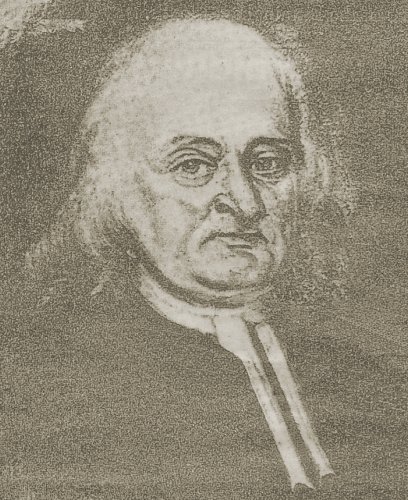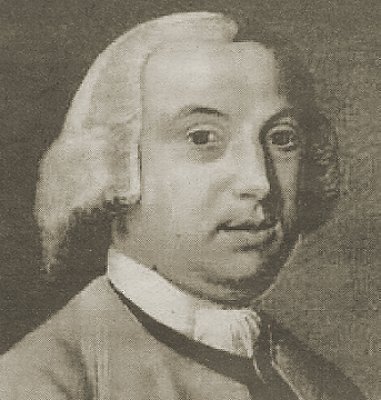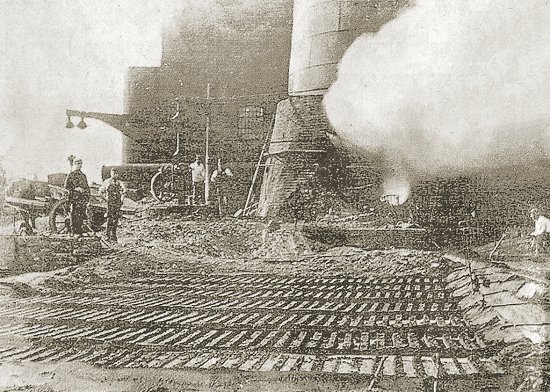|
Ironmasters with a pivotal role in the
industrial revolution
In an age of great figures whose
achievements made their mark upon the making of the modern
world, Sampson Lloyd II was one of the most influential, and yet
today is one of the least known. Matthew Boulton, James Watt,
William Murdock and Joseph Priestley still attract renown and
have statues to commemorate them, but in the years immediately
before they came to prominence, Lloyd played a pivotal role in
the beginnings of the Industrial Revolution.
Through his business as an ironmaster, he
provided the iron and steel that was so crucial for the making
of so many metal things. Then as the pace of economic change
gathered speed he provided another impetus through his bank,
Taylor's and Lloyd's, which loaned much of the money to power
manufacturing forward further and faster.
|
| Sampson's father, Sampson Lloyd I, had come
to Birmingham from Dolobran in Montgomeryshire as the 17th
century waned.
A Quaker, he was attracted by the town's reputation
for religious tolerance and also, it seems, by the
proximity of the family of his second wife, Mary nee
Crowley.
Her father, Ambrose Crowley II was a
remarkable man. A Quaker, he was born in Rowley Regis and was
the son of a nailer who owned moveable goods valued at £24 at
his death in 1680.
By comparison, Ambrose the second went on to
leave almost £1,200 when he died. His fortune had been made by
iron and it seems that the late 17th and early 18th centuries
were favourable times for enterprising and talented men from
humble beginnings such as he to wax wealthy. |

Ambrose Crowley II of Stourbridge
founded a dynasty of iron masters. |
|
Slitting mills
The rise of the Crowleys was spectacular;
so too was that of the Foleys. This family was responsible for
expanding industrial output in northeast Worcestershire and
south Staffordshire through the introduction of slitting mills.
This innovation was crucial to the massive growth in nail making
by hand. A piece of machinery with rotary cutters that was
worked by a water wheel, it cut (slit) thin iron sheets into
narrow strips and rods for nail making and other purposes. The
iron was made thin beforehand when a bar was hammered flat and
then squeezed even flatter between metal rolls in a rolling
mill.
According to an old story, Richard Foley
was a fiddler from Stourbridge who wished to learn about the new
slitting mills that had appeared in Sweden. He worked his
passage from Hull to Scandinavia and then paid his way to the
slitting mill by playing his fiddle. Here he became friendly
with the workmen and found out the mysteries of their trade.
Returning home he set up works with a partner, but as he had
forgotten some of the secrets on the long journey back he had to
make another expedition to fill in the gaps in his knowledge.
This he achieved and his mill was a great success and he became
wealthy.
Another story has Foley as a nailer who was
a drunkard who had his cow taken for his debts, after which he
went to Holland and returned with the invention of the slitting
mill. Such stories are embellished with fantasy but there is a
grain of truth in the recognition of Richard Foley as the key
figure in the introduction of slitting mills to England. His
importance is made plain in a most important book by Roy Peacock
called 'The Seventeenth Century Foleys. Iron, Wealth and Vision
1580 - 1716', which is published by the excellent Black Country
Society. Based on deep and thorough research, Roy brings to life the progress
of the Foleys. Richard himself was the son of a nailer from
Dudley. He became the most successful ironmaster of the age and
the slitting mill he set up on the River Stour from the late
1620s was vital to his ascendancy.
Foley was not the first person to open such
a mill in England, but he was the first to do so successfully
and in the long term. Henceforth more rods could be made more
cheaply and more quickly than slitting by hand. This allowed a
vastly increased output of nails, which were essential in an age
when so much was made of wood.
Based in Stourbridge from 1630, Richard
Foley built up a considerable undertaking so that by his death
in 1657 the family's ironworks accounted for over half of the
total iron production in the West Midlands and perhaps as much
as a quarter for the whole of England and Wales. Roy Peacock's
shows how Foley's children expanded their holdings into iron
making in north Staffordshire and the Forest of Dean,
gun-founding in the Weald of Kent, and into trade in London.
However by the early 18th century, the Foleys were moving away
from iron and into land - and as they did so other families such
as the Crowleys became pre-eminent in the making and trading of
iron.
|

A Black Country blast furnace and
coal mines. The Lloyds were among the pioneers of blast
furnaces in the region at the Old Park Works in
Wednesbury, in 1825-26. |
|
Achievements
When Ambrose Crowley the second died in
1680 he owned a steel-making forge and an iron-making forge in
Stourbridge; he was an ironmonger of standing, putting out work
to a host of nailmakers and buying their goods from them to sell
on; he had a share in an iron works in Brecknock; and he was a
partner in a company that aimed to supply water to Exeter and
Barnstaple. These considerable achievements were surpassed
mightily by his son, Sir Ambrose. He shifted the nailmaking
operations to the north east of England and his trading centre
to London. So successful was he, especially in selling nails to
the Royal Navy, that upon his death in 1713 he left the vast
amount of more than £100,000.
Despite his move away from the West
Midlands and his undercutting of the prices of local
ironmongers, Crowley kept his interests in the Stour Valley and
he forged a strong link with Sampson Lloyd I. With little
experience of either manufacturing or trading, the Welsh migrant
to Birmingham soon became knowledgeable of both. He started up
as an ironmonger, fetching in iron from distant furnaces to sell
to local forges and slitting mills and then buying back from
them bar iron and rod iron to sell to putters out - the men who
supplied nailers and smiths.
|
|

Sampson Lloyd II - a leading
figure among iron masters. |
In this business Sampson I benefitted both
from the advice and custom of his brother-in-law, Sir Abraham
Crowley.
The knight bought rod iron from Lloyd for his slitting
mills to supply to nailers in the north of England, while
Crowley's mills in County Durham produced bar steel which was
distributed to edge tool makers in the Midlands by Lloyd.
With
no canals then to speed the movement of goods, it was a long
journey to Birmingham. The steel was taken by boat from the
north east to London and was then carried to the town.
This
expensive movement was made possible by the high value of steel
compared to its weight, as opposed to the lower value of iron. |
|
Sampson the first died in 1725. When he had
arrived in Birmingham it is said that he had nothing. This seems
unlikely given his background and close relationships with
wealthy families locally. Still, he may have had only 'modest'
means by middle class standards but through hard work,
integrity, and the development of family contacts with other
leading Quaker families he transformed his fortunes and became a
wealthy man, leaving £10,000.
His business was passed on to his eldest
son, Sampson II who had been apprenticed at a brass-wire firm in
Bristol where his father had an agent. The younger Sampson drove
forward the Lloyd's operations. If his father had laid the
foundations it was Sampson Lloyd II who successfully built upon
them and made himself one of the most influential businessmen in
the Midlands at an extraordinary time; the beginnings of the
Industrial Revolution.
His first wife, Sarah, was another
well-connected Quaker woman, for her father was Richard Parkes
an ironmaster from Wednesbury who had settled in Birmingham;
while his second wife, Rachel, was the daughter of Nehemiah
Champion, a Quaker merchant from Bristol with metallurgical
interests. Of their three daughters, Mary married Osgood
Hanbury, a Quaker merchant who had an extensive concern in
trading with the American colonies; and Rachel married David
Barclay, another leading Quaker merchant and also a banker.
Still, it was Sarah Parkes who provided what would become a
longstanding and crucial link between the Lloyds and Wednesbury.
Her father, Richard, had arrived in the
town from the Cotswolds in 1690 and like Sampson Lloyd I, his
rise to riches was greatly helped by a fortunate marriage - in
his case to Sarah, the daughter of Henry Fidoe. The son of a
small-scale ironmonger in Wednesbury, Fidoe became an active
Quaker with wide interests in the iron trade in Staffordshire.
It would seem that as Sir Ambrose Foley had
helped Samson Lloyd I, so too did Henry Fidoe help his
son-in-law, for Richard Parkes went on to become one of the
biggest customers of the Foleys. Parkes then built on these
strong foundations and invested in the future by buying land and
buildings in and around Wednesbury. Most importantly he also
purchased local surface and mining rights.
These latter weren't much exploited during
most of the 18th century, simply because of the inability to
effectively pump out the water that flooded deeper coal and
other mines. But the development of the steam engine transformed
this situation and made mineral rights a most valuable
possession.
Its potential for creating wealth was
recognised in the early 19th century by Samuel Lloyd II Known
popularly as Quaker Lloyd, he inherited the Parkes properties,
and then in 1839 added to them with 108 acres that came to him
through his Fidoe ancestry. It was by this connection that
eventually the great firm of F. H. Lloyd would be set up in the
Black Country.
That was in the future, for now in the 18th
century the Lloyd's affairs grew rapidly under the guidance of
Sampson the second. It was he who created what would be regarded
today as an integrated structure of businesses. Pig iron came
from a blast furnace at Melbourne in Derbyshire, while it was
converted into bar iron at Burton upon Trent, and the family
owned another forge at Powick near Worcester. This bar iron was
then taken to Lloyd's slitting mill at Birmingham, which had
been bought in 1728 by Charles Lloyd, the older brother of
Sampson II.
The first proper plan of Birmingham dates
to three years later. It shows Lloyd's slitting and corn mills
on the corner of Lower Mill Lane and what would become Bradford
Street. It was in a most prominent position with easy access to
the important through-route of Digbeth and was powered with
water from the nearby River Rea. This mill came into the
ownership of Sampson II in 1741 after his brother died.
|
| Bull Street, Birmingham, in
1956. The Minories is on the right and the Friends
Meeting House and burial ground was further up, just
before the building that juts out.
The Friends still meet on
virtually the same spot as they have done since 1703.
This is where the Lloyds,
Parkes, Fidoes, and Pembertons met to worship. |
 |
| In Stourbridge, the local
Friends gather in an older meeting house leased to them
in 1689 on a peppercorn rent by Ambrose Crowley II. |
|
Wealth
Fourteen years afterwards it was described
in 1755 by some Londoners who visited the Pembertons, close
relatives of both the Lloyds and Fidoes and another Quaker
family that made its wealth from iron. It was: "too curious to
pass by without notice. Its use is, to prepare Iron for making
nails. The process is as follows: They take a large iron bar,
and with a huge pair of shears, worked by a waterwheel, cut it
into lengths of about a foot each; these pieces are put into a
furnace, and heated red-hot, then taken out and put between a
couple of steel rollers, which draw them to the length of about
four feet, and the breadth of about three inches; thence they
are immediately put between two other rollers, which having a
number of sharp edges fitting each other like scissors, cut the
bar as it passes through into about eight square rods; after the
rods are cold, they are tied up in bundles for the nailor's
use".
Lloyd's workers also produced bar iron,
which was used by smiths across the land to make a wide range of
iron goods, and steel for the cutlery, blade and edge-tool
industries. On top of this Lloyd acted as an ironmonger, selling
the finished goods of smiths and nailers to London markets
especially.
|

A Black Country scene that was
familiar in the latter 18th century - mines, machinery,
steam and canals. |
Sampson Lloyd II was a leading figure among
the great names of a dynamic, exciting and sometimes confusing
era that changed the world,
He was a contemporary of Matthew Boulton, perhaps the
most famed industrialist of the age, and joined with him
and others in supporting the cutting of the Birmingham
Canal.
From its full opening in 1772 this linked the town
with the coal and iron deposits in the Black Country.
|
|
It was the first of the canals that soon would
enable Birmingham's manufacturers to reach the world
more easily through readier access to ports such as
London, Bristol and Liverpool.
A self-effacing man, Sampson Lloyd II was
also a pivotal figure in the banking revolution that was so
crucial to the Industrial Revolution, by way of providing the
finances for the rapid expansion of manufacturing. In 1765 he
and his eldest son, Sampson III, joined with John Taylor the
Brummagem button king and his son to found the first real bank
in Birmingham - that of Taylor's and Lloyd's.
Their premises were in Dale End and are
remembered today by a blue plaque placed by the Birmingham Civic
Society, and indirectly Sampson Lloyd II had a major impact on
the growth of Wednesbury in the 19th century through the
legacies of his father-in-law, Richard Parkes, and of his Fidoe
cousins. Ultimately they led to the arrival in the town of
Sampson's great grandson, Samuel Lloyd II who would go on to
establish one of the chief ironworks in the Black Country; while
his great, great, great grandson, Francis Henry, would found the
celebrated company of F. H. Lloyd, a name that resonates still
with pride for the folk of Wednesbury and Darlaston especially.
|
 |
Return to
the
previous page |
|